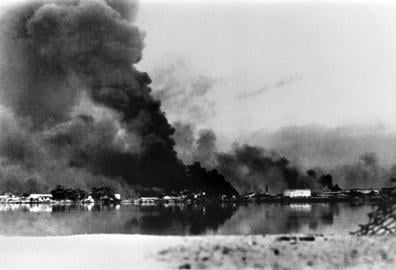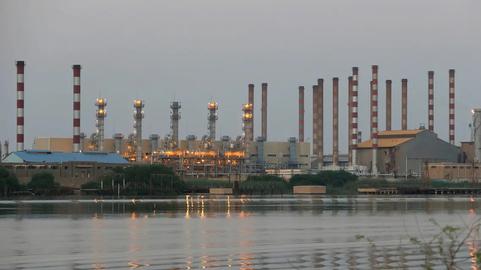In the 42 years since the Islamic Republic was formed, Iran’s domestic oil production has never once reached its pre-revolution rates. A new report by Iran Open Data has charted the country’s beleaguered attempts to improve outputs since 1979 and the factors that stood in the way.
Today, the authors conclude, “Tehran has found itself in a position where the oil industry under the Islamic Republic does not appear to be in charge of its own destiny”.
Oil Production Down 22 Percent – Even as Reserves Soar
The report compared BP’s statistical global energy records from the last 10 years of the Shah’s reign to the Islamic Republic’s performance from 2010 and 2019.
From 1969 to 1978, a steady increase in oil production was recorded, averaging 5.11 million barrels a day. By comparison, between 2010 and 2019 the average output of the Islamic Republic was just 4.18 million barrels per day: a comparative decline of 22 per cent.
Each government since the revolution has recorded a decline in average production rates compared to the Shah’s time, from -23.4 percent to a historic low of -63.4 percent.
Meanwhile, researchers found that Iran’s global status as a major oil producer has also significantly diminished. In the eight years before the Islamic Revolution, Iran supplied an average of 9.5 percent of global demand and in some cases more than 10 percent.
But in the last eight, the average had contracted to 4.5 percent, reaching an absolute high of five percent. In 2019, the rate dropped to 3.7 percent.
The researchers note: “This was not due to a decline in Iran’s resource base. In fact, Iran’s oil reserves increased from 58.3 billion barrels in 1980 by 267% to 155.6 billion barrels in 2019.”
So, what went wrong?
War and International Isolation Obstructing Sales
During the Shah’s reign, the report indicates, Iran was a global leader in oil production due to several key factors that no longer stand today.
Between 1965 and 1978, most of Iran’s oil production came from onshore fields managed by the International Oil Consortium – which had replaced the Anglo-Iranian Oil Company – but Iran also had contracts with international firms such as Italy’s ENI and the US company AMOCO.
The country was able to quickly put new oil fields into production, with the latest technologies at its disposal, thanks to collaboration with international firms.
After the 1973 Arab-Israeli war, Iran - along with Indonesia and Nigeria – also did not participate in the Arab oil embargo and continued to supply oil to Western countries. As a consequence Iranian oil was selling as high as US$17 per barrel in December 1973.
The last year of the Shah’s reign, 1978, was due to be another high-production year but was hampered by oil strikes in the fourth quarter. Nonetheless, even in this difficult year, Iranian oil still accounted for about 8.5 percent of global demand.
Since the Islamic Revolution, a perfect storm of geopolitical and internal factors have kept Iran’s oil output below pre-1979 rates. Foreign experts left in droves after the revolution and the isolation that followed the 1979 US Embassy hostage crisis saw Iran’s oil output drop to an all-time low of 1.3 million barrels per day.
The 1980-1988 war with Iraq then left Iran’s oil facilities damaged and compromised at a time when regional competitors were building infrastructure and fostering better relations with OPEC. Even in the post-war reconstruction era under President Hashemi Rafsanjani, Iran struggled to secure international investment. The Clinton administration cancelled Iran’s first post-revolution upstream contract with a US firm.
Under President Khatami, from 1997 to 2005, Iran signed contracts with a plethora of international firms including Shell, OMV, Statoil and ENI and managed to hold its output at an average of 3.9 million barrels throughout.
After President Ahmadinejad came to power, Iran initially benefitted from high global demand and prices. But the country’s renewed hardline stance and fallout over the nuclear program led to fresh sanctions, and a fresh period of global isolation. During Ahmadinejad’s tenure many international companies also left Iran and the domestic industry was starved of new technology.
The Rouhani administration has also been blighted by the roller-coaster of sanctions and a lack of innovation. Over the past eight years, Iran Open Data observes, average production has remained at 4.15 million barrels a day – respectable in the circumstances, but still significantly below the level recorded more than four decades ago, in which time Iran’s oil reserved have almost tripled.
The authors surmise: “Given the poor performance of the Islamic Republic in the past four decades - and its current nuclear and foreign policies especially vis-à-vis the United States - Iran is highly unlikely to reach its pre-revolution status in oil production anytime soon.”
Related coverage:
Four Iranian Tankers Head for Syria in Defiance of Sanctions
When Will US Sanctions Hit Iranian Oil Sales?
Iran Sets Out Conditions for the Revival of the Nuclear Deal (At Least on Paper)
Oil, the Dollar and Inflation: How Far Can the Economic Crisis in Iran Go?
visit the accountability section
In this section of Iran Wire, you can contact the officials and launch your campaign for various problems



























comments